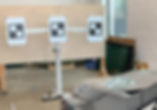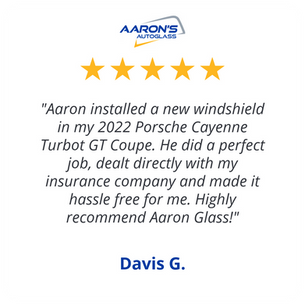CALL 1-774-202-2963


Advanced Driver Assistance System Calibration Services
Understanding the ADAS Calibration Process
At Aaron's AutoGlass, the calibration of your ADAS system is a precise and meticulous process carried out with the utmost care. Following OEM standards, our team uses specialized calibration equipment and deep expertise to ensure sensor accuracy and that camera systems are perfectly aligned and functioning as intended to provide maximum safety.

What is an ADAS System?
Ensure Optimal Performance of Your
Vehicle's Safety Features
The wonderful thing about newer vehicles as they hit the marketplace is the amount of new-age technology built into their design to create a safer driving experience. What many don't realize is that a percentage of that technology is built into your vehicles auto-glass.
An Advanced Driver Assistance System (ADAS) refers to a suite of electronic technologies designed to assist drivers in controlling their vehicles more safely and efficiently. These systems utilize sensors, cameras, and radar to monitor vehicle surroundings, detect potential hazards, and make real-time decisions to prevent accidents.

Common Features of ADAS System include:
-
Blind Spot Detection
-
Lane departure warnings
-
Adaptive cruise control
-
Automatic emergency braking
-
Parking assistance
-
Forward collision prevention
-
Backup collision prevention
Many of these systems rely on sensors and cameras mounted on or near the windshield. This is where ADAS calibration becomes crucial. Whenever the vehicle's windshield is replaced or any components related to these systems undergo maintenance or repair, recalibration is necessary to maintain the functionality and accuracy of the ADAS features. Without proper calibration, the systems may fail to detect obstacles, misjudge distances, or provide inaccurate warnings, potentially compromising the safety of passengers.

How is ADAS Calibration Performed?
At Aaron's AutoGlass our calibration process ensures that your vehicle's sensors and cameras are aligned correctly, allowing (ADAS) Advanced Driver Assistance Systems to function as the vehicle manufacturer intended. Here’s how our meticulous process is carried out:
Before commencing any calibration, our techs will perform a thorough inspection of the vehicle's current condition. This includes checking for any visible damage to electronic sensors or cameras, ensuring they are clean, and verifying that the vehicle is on level ground. Any necessary repairs must be addressed before calibration begins.
Calibration requires specialized tools and equipment. Our team uses industry specific ADAS calibration tools such as ADAS calibration frames, laser emitters, and calibration targets specifically designed for each vehicle model. Using OEM procedure our team will use these tools ensure that the calibration is performed with highest level of precision.
Types of Calibration Offered at Aaron's AutoGlass
Aaron's follows OEM standards for ADAS Calibration
Static calibration usually requires specialized equipment, such as target boards and laser alignment tools, to ensure that cameras and sensors are aligned correctly according to manufacturer specifications. This type of calibration is generally performed indoors in a controlled environment and is crucial for sensors like those used in lane-keeping assist, which rely on precise spatial orientation.
At Aaron's AutoGlass, our technicians meticulously position the targets in relation to the vehicle, ensuring that all systems are recalibrated for optimal performance even when the vehicle is not in motion. Reach out to our team by calling 774-202-2963 for questions about your ADAS system or to schedule service.

Dynamic calibration uses real-world conditions to allow the cameras and sensors to self-adjust and synchronize as the car is driven. Some vehicle manufacturers recommend or require this method, as it allows ADAS components to adapt to the specific positioning and movement dynamics of the individual vehicle.
During dynamic calibration, our expert technicians follow a carefully prescribed route and driving pattern under specific conditions. This is to ensure that all ADAS systems, such as lane departure warning, adaptive cruise control, and automatic emergency braking, are properly calibrated and ready to keep drivers safe on the road. Reach out to our team by calling 774-202-2963 for questions about your ADAS system or to schedule service.
In some cases, vehicles may require both static and dynamic calibration. This is referred to as Dual Calibration.
When Should My ADAS System Be Recalibrated?
Proper Sensor and Camera Alignment is Vital for Vehicle Safety
Guaranteeing precise calibration of your Advanced Driver Assistance System (ADAS) is crucial for the effective operation of its safety functions. When you replace a vehicle windshield or require rock chip repair, look for these key signs indicating recalibration might be needed. Please be aware that Aaron's AutoGlass exclusively offers ADAS Camera Calibration for vehicles receiving auto glass repairs or replacements from their service only.

After a Windshield Replacement
It’s crucial to recalibrate your ADAS for key vehicle safety features

One of the most common situations necessitating ADAS recalibration is after a windshield replacement. Even the slightest misalignment during installation can impact the camera view, affecting the system's performance. Modern windshields often come equipped with cameras and sensors that are integral to ADAS. Thus, precision in repositioning is vital.
If you do not recalibrate these systems, they can fail. This failure can harm important safety features like lane departure warnings and automatic emergency braking. It can cause wrong readings or slow responses. This can undermine the vehicle’s ability to react to hazards promptly, increasing the risk of accidents.
Recalibration ensures that all sensors and cameras operate within their designated parameters, restoring the correct alignment and functionality. This process typically involves using specialized equipment and software to align the vehicle's cameras and sensors to precise manufacturer specifications.

Following a Rock Chip Repair
Minor changes to your windshield can compromise sensors

After a rock chip repair, it’s crucial to assess whether recalibration is necessary, especially if the damage was near the areas housing Advanced Driver Assistance System (ADAS) sensors or cameras. The functionality and accuracy of ADAS sensors and cameras can be compromised even by minor changes to your windshield. These systems rely on precise alignment to maintain optimal performance, ensuring features such as lane-keeping assistance, adaptive cruise control, and collision avoidance operate as intended.
Post-repair calibration ensures that the ADAS components are properly aligned and functioning accurately, which is crucial for maintaining safety and effectiveness on the road. Skipping this step can lead to misreads or false detections, potentially putting you and others at risk.

If You See an
Error Code
Pay Attention to Warning Signals and Eradic ADAS Behavior.

Sensor errors that necessitate an ADAS camera calibration often arise from events such as a windshield damage that necessitate an auto glass repair or windshield replacement. If the camera's field of view is misaligned, miscalibrated, or obstructed, it may produce inaccurate data, leading to potential safety hazards.
Signs that indicate a need for calibration include warning lights or error messages illuminating on the dashboard, erratic or incorrect ADAS behavior, or even preventive routine maintenance after the aforementioned events. Ensuring that sensors are properly calibrated is crucial for the accuracy and reliability of ADAS features, maintaining both vehicle safety and driver confidence.

Experience Signs of Misalignment
Pay Attention to Warning Signals and Eradic ADAS Behavior.

It's crucial to recognize the signs indicating potential misalignment. If you experience any warnings from your ADAS features or notice them not functioning optimally, it might suggest the need for recalibration.
If you are scheduling a windshield repair or replacement and have experienced erratic lane departure warnings, inappropriate activation or deactivation of cruise control settings, or inconsistent collision warnings please notify a member of our staff so we can perform a pre-calibration assessment.









